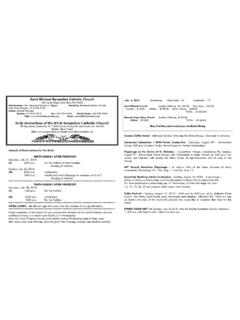Transcription of Diagnosis and control of epilepsy in the cat CLARE …
1 COMPANION ANIMAL PRACTICE Two-year-old male domestic shorthaired cat with idiopathic epilepsy , which presented in status epilepticus. After a loading dose of phenobarbital (15 mg/kg intramuscularly divided over a 30-minute period), the patient was sedated with propofol which had been mixed with sodium chloride and administered via an infusion pump; 1 5 ml/hour propofol over 24 hours was required to control the seizures. The infusion was then gradually withdrawn over the following 48 hours Diagnosis and control of epilepsy in the cat CLARE RUSBRIDGE. SEIZURES are the one of the most common presentations in the neurological feline patient and can be a daunting prospect for the veterinary clinician. The list of possible differential diagnoses is huge and demands a careful and systematic diagnostic approach. This article steers the practitioner through the work-up and provides guidance on the provision and monitoring of antiepileptic drug therapy in cats.
2 PREVALENCE AND MANIFESTATION PREVALENCE OF epilepsy IN A REFERRAL POPULATION OF. CATS AND DOGS*. Idiopathic (primary) epilepsy is less common in cats Cats Dogs CLARE Rusbridge graduated from than in dogs (see table on the right). Idiopathic epilepsies Idiopathic epilepsy 54% 68%. Glasgow in 1991 and in dogs are generally genetic, but there is little evidence Extracranial pathology 4% 5%. completed a small of this in the cat. It is probable that a considerable (eg, metabolic derangement animal internship proportion of the idiopathic feline group actually have such as hepatic encephalopathy). at the University of Pennsylvania, USA. acquired epilepsy , but no obvious structural lesions are Intracranial pathology 42% 27%. After a year in small (eg, neoplasia). animal practice in seen on magnetic resonance imaging (MRI). Cambridgeshire, *From data collated at the author's referral practice Tonic-clonic generalised seizures are the most com- Reactive seizures are more common in general practice she joined the Royal Veterinary College mon type of seizure seen in dogs, but are less often (RVC) to undertake observed in the cat.
3 Complex partial seizures, during a BSAVA/Petsavers residency in which animals may remain in sternal recumbency or cranial causes may be further subdivided into idiopathic neurology and can be very active (eg, running and climbing), are typical (ie, primary/genetic) and acquired (ie, secondary/sympto- subsequently spent in cats. Urination and defecation may be seen. Some matic/cryptogenic). For prognostic purposes, it is useful to a year at the RVC as a staff clinician in seizures last only a few seconds (eg, face twitching divide acquired epilepsy into static and progressive brain neurology. She or blank' staring). Generally, such cats will have multi- disease. currently runs a small animal neurology ple episodes a day. In the referral service at the author's experience, many Stone Lion Veterinary Centre in London. She epileptic cats have cluster Classification of seizures is an RCVS specialist seizures as their first in veterinary Seizures seizure event.
4 While this is neurology and is board-certified by the a poor prognostic sign in European College of dogs, this does not appear Veterinary Neurology. Extracranial causes Intracranial causes to be the case in cats and good seizure control may be achieved easily. Excess/deficit Toxins Idiopathic epilepsy Acquired epilepsy (eg, glucose, electrolytes). APPROACH TO. Diagnosis . External Internal Progressive brain Static brain The causes of seizures are (eg, poison) (eg, liver, kidney) disease (eg, brain disease (eg, scar). traditionally divided into intracranial and extracranial tumour). In Practice (2005). 27, 208-214 (see box on the right). Intra- 208 In Practice APRIL 2005. DIFFERENTIAL Diagnosis OF SEIZURES IN CATS. Type Conditions D Degenerative Lysosomal storage disease A Anomalous Hydrocephalus, lissencephaly M Metabolic Hepatic encephalopathy, hypoglycaemia, hypocalcaemia, uraemia, hypertriglyceridaemia, hypernatraemia, polycythaemia vera (primary erythrocytosis), post-metabolic acquired epilepsy , hypoxia, hyperosmolarity, mitochondrial encephalomyelopathy N Neoplastic Primary and secondary brain tumours Nutritional Thiamine (vitamin B1) deficiency (raw or overcooked fish diet, anorexia).
5 I Inflammatory Granulomatous meningoencephalomyelitis, eosinophilic meningoencephalomyelitis, feline polioencephalomyelitis Infectious Feline infectious peritonitis, toxoplasmosis, feline immunodeficiency virus infection, Cryptococcus infection, post-infection acquired epilepsy , abscess Idiopathic epilepsy where all diagnostic tests such as haematology, cerebrospinal fluid analysis, viral titres and magnetic resonance imaging are normal Iatrogenic Post-surgical acquired epilepsy T Traumatic Trauma to the cerebrum or diencephalon, post-traumatic epilepsy Toxic Lead, organoarsenicals, organomercurials, organophosphates, chlorinated hydrocarbons, bromethalin, pyrethrins, metaldehyde, strychnine, metronidazole V Vascular Cerebral ischaemic necrosis (feline ischaemic encephalopathy). Histopathology section from the medulla of a three-year- old female cat which presented with seizures.
6 The cat had a progressive gait abnormality characteristic of cerebellar Easily confused non-epileptic conditions disease and was deaf. The nerve cells (arrows) are full of a storage material which was autofluorescent under Myoclonus ultraviolet light. This is characteristic of ceroid lipofuscinosis. Haematoxylin and eosin stain. Magnification x 400. Myoclonus is an occasional Diagnosis in cats and is characterised by a brief, Picture, Dr Caroline Hahn, Neuromuscular Laboratory, repetitive contraction of a muscle/muscle group. Occasionally, myoclonus can University of Edinburgh be induced by a repeatable stimulus (eg, sudden movement in the visual field). or may be seen at certain times (most commonly as the animal falls asleep). The list of differential diagnoses for seizures is huge and, as with most aspects of neurology, it is easiest to sub- Mutilation categorise them using the DAMNIT-V system (see table, Syndromes leading to mutilation are rarely the result of seizures although some above right).
7 This list can be daunting and, hence, the of these conditions may respond to anticonvulsant drugs. A common example is work-up of an epileptic patient requires a systematic a (presumed) orofacial pain syndrome, which causes the cat to paw at, and muti- approach to narrow down the likely cause of the seizures. late, its mouth/tongue. This is especially seen in Burmese cats. HISTORY Syncope Good history taking is of paramount importance, as seizures Syncope is very rare in cats. can be easily confused with other causes of collapse or movement disorders (see box on the right). It is very helpful to have a video recording of the suspected seizure. Transverse T2-weighted MRI scan from an 11-month-old cat which presented with a three-week history of seizures. The image shows high signal intensity, which is characteristic of oedema, within the caudate lobes (arrow).
8 There is also a high signal area within the periaqueductal grey matter. This appearance on MRI is typical of a mitochondrial encephalopathy (ie, a mitochondrial enzyme defect). Urinalysis revealed a citric aciduria. The cat was given supplements containing the mitochondrial cofactors, Nine-month-old cat with hepatic encephalopathy, showing L-carnitine and coenzyme Q, together with thiamine and stunting and copper-coloured irises, which are typical riboflavin. The seizures ceased and the animal's demeanour of cats with congenital portosystemic shunts. Serum improved markedly it became more active, and started biochemistry revealed low urea and low-normal albumin to play and go outside levels and raised resting bile acid values In Practice APRIL 2005 209. (above) Transverse T1-weighted gadolinium-enhanced MRI. scan of the brain of a one-year-old domestic shorthaired cat Transverse T1-weighted gadolinium-enhanced MRI scan with feline infectious peritonitis.
9 There is mild ventricular of the brain showing a meningioma in a 14-year-old male dilation, which is occurring secondarily to obstruction domestic shorthaired cat which presented with seizures. The of cerebrospinal fluid pathways. There is meningeal tumour is seen as an enhanced (white) area with contrast. enhancement suggesting an inflammatory or neoplastic Note the thickened bone (black) adjacent to the tumour infiltrate (arrow). Cerebrospinal fluid analysis revealed a (hyperostosis) and the spread of the tumour along neutrophilic pleocytosis and a high anti-FCoV antibody titre. the meninges (arrow). (below) Histopathological sample showing the cerebral cortex. There is massive inflammatory cell influx (basophilic The timing and nature of a seizure may provide clues cells, arrow) in the meninges, which explains why the area was enhanced on MRI.
10 Haematoxylin and eosin. Magnification x 20. about its aetiology. For example, partial seizures suggest a focal lesion. It can be difficult to distinguish partial sec- ondary generalised seizures from primary generalised ones in such cases, ask the owner if the seizure starts in one body part or is asymmetrical (eg, only in one side of the face). Establish if the animal is normal between seizures. Abnormal behaviour in the interictal period, such as lethargy, aimless wandering, and inappropriate urination and defecation, implies an intracranial patholo- gy. Finally, explore the possibility of a past medical his- tory (eg, head trauma) or a previous Diagnosis of systemic illness such as toxoplasmosis or diabetes. NEUROLOGICAL EXAMINATION. A neurological examination is invaluable, yet its impor- tance is often underestimated. The aim is to answer three main questions, discussed below.






